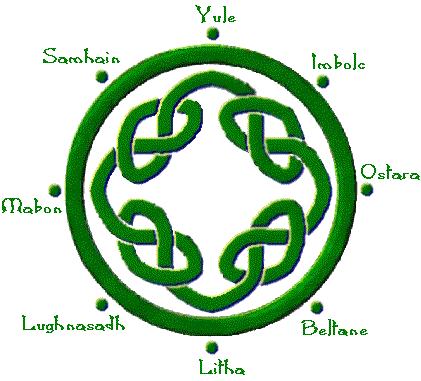
Ostara
March 21 - 25th
Spring Equinox
OSTARA (pronounced O-STAR-ah) is one of the Lesser Sabbats, and is usually celebrated on the Vernal or Spring Equinox right around March 21 (although because of its origins, may instead be celebrated on the fixed date of March 25). Other names by which this Sabbat may be known are Oestara, Eostre's Day, Rite of Eostre, Alban Eilir, Festival of the Trees, and Lady Day. The Christian holiday of Easter is very near this same time, (notice the similarity in name?), and is determined as the first Sunday after the first Full Moon after the Vernal Equinox.
The name for this Sabbat actually comes from that of the Teutonic lunar Goddess, Eostre. Her chief symbols were the bunny (for fertility and because the Ancient Ones who worshipped her often saw the image of a rabbit in the full moon), and the egg (representing the cosmic egg of creation). This is where the customs of "Easter Eggs" and the "Easter Bunny" originated.
Ostara is a time to celebrate the arrival of Spring, the renewal and rebirth of Nature herself, and the coming lushness of Summer. It is at this time when light and darkness are in balance, yet the light is growing stronger by the day. The forces of masculine and feminine energy, yin and yang, are also in balance at this time.
At this time we think of renewing ourselves. We renew our thoughts, our dreams, and our aspirations. We think of renewing our relationships. This is an excellent time of year to begin anything new or to completely revitalize something. This is also an excellent month for prosperity rituals or rituals that have anything to do with growth.
In the Wheel of the Year, this is the time when the great Mother Goddess, again a virgin at Candlemas, welcomes the young Sun God unto her and conceives a child of this divine union. The child will be born nine months later, at Yule, the Winter Solstice.
Ostara is a fertility festival celebrating the birth of Spring and the reawakening of life from the Earth. The energies of Nature subtly shift from the sluggishness of Winter to the exuberant expansion of Spring. Eostre, the Saxon Goddess of fertility, and Ostara, the German Goddess of fertility are the aspects invoked at this Sabbat. Some traditions worship the Green Goddess and the Lord of the Greenwood. The Goddess blankets the Earth with fertility, bursting forth from Her sleep, as the God stretches and grows to maturity. He walks the greening fields and delights in the abundance of nature.
Customs such as the lighting of new fires at dawn for cure, renewed life, and protection of the crops still survive in the Southern Americas as well as in Europe. Witches celebrate Ostara in many ways on this sacred day, including lighting fires at sunrise, ringing bells, and decorating hard-boiled eggs which is an ancient Pagan custom associated with the Goddess of Fertility. In those ancient days, eggs were gathered and used for the creation of talismans and also ritually eaten. The gathering of different colored eggs from the nests of a variety of birds has given rise to two traditions still observed today - the Easter egg hunt, and coloring eggs in imitation of the various pastel colors of wild birds. It is also believed that humankind first got the idea of weaving baskets from watching birds weave nests. This is perhaps the origin of the association between colored Easter eggs and Easter baskets.
The most common colors associated with Ostara are lemon yellow, pale green and pale pink. Other appropriate colors include grass green, all pastels, Robin's egg blue, violet, and white. Stones to use during the Ostara celebration include aquamarine, rose quartz, and moonstone.
 Free Forum Hosting
Free Forum Hosting